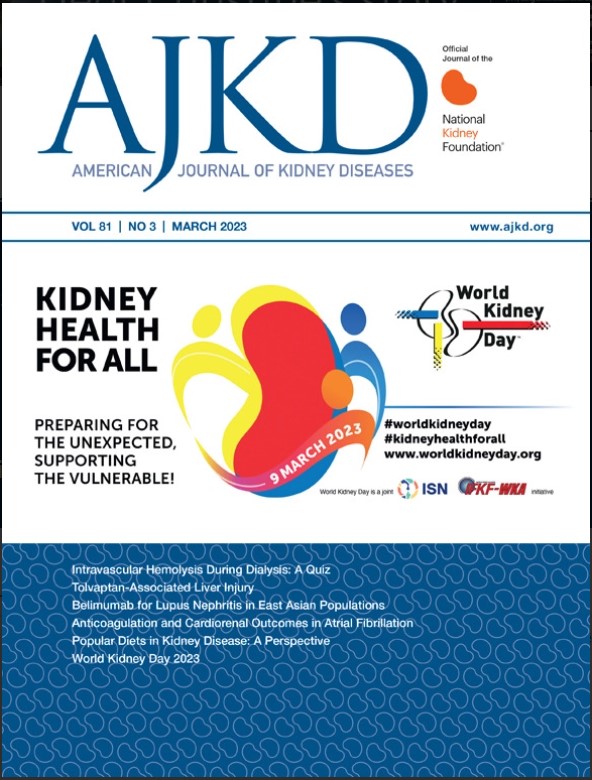Long-Term Exposure to Uranium and Arsenic in Community Drinking Water and CKD Risk Among California Women
IF 8.2
1区 医学
Q1 UROLOGY & NEPHROLOGY
引用次数: 0
Abstract
Rationale & Objective
Metals/metalloids in drinking water, including uranium and arsenic, may damage kidney function and increase chronic kidney disease (CKD) risk. We evaluated exposure to these contaminants in community water supplies (CWS) and CKD risk in the California Teachers Study.
Study Design
Prospective cohort study.
Setting & Participants
88,185 women who were California teachers and school administrators enrolled 1995-1996.
Exposure
Time- and residence-weighted annual average uranium and arsenic concentrations from CWS serving participants’ residential addresses from 1995 to 2005.
Outcome
6,185 moderate to end-stage CKD cases from hospitalization records between 2005 and 2018.
Analytical Approach
Hazard ratios and 95% confidence intervals calculated using mixed-effects Cox models, adjusted for age as the time scale, body mass index, smoking status, race and ethnicity, neighborhood socioeconomic status, and census region as a random effect. Analyses were also stratified by risk factors and comorbidities.
Results
Most exposures in this population were below the current regulatory limits (uranium: 30 μg/L; arsenic: 10 μg/L), with median concentrations of 3.1 μg/L (IQR, 0.9-5.6 μg/L) for uranium and 1.0 μg/L (IQR, 0.6-1.8 μg/L) for arsenic. Uranium exposure was positively associated with CKD risk (continuous log, per IQR; HR, 1.11 [95% CI, 1.02-1.20]). Compared with uranium exposure < 2 μg/L (World Health Organization 1998 guideline), the risk was over 30% greater at 10 to <15 μg/L (HR, 1.33 [95% CI, 1.15-1.54]) and similar at ≥15 μg/L (HR, 1.32 [95% CI, 1.09-1.58]). There was no evidence of a significant association between arsenic and CKD overall (log, per IQR; HR, 1.02 [95% CI, 0.98-1.07]). However, the risk from arsenic was greater among younger individuals (≤55 years) and those who developed cardiovascular disease or diabetes.
Limitations
Individual tap water use and consumption; limited generalizability to men and non-White and less affluent populations.
Conclusions
Uranium below the current regulatory limit from community water may increase CKD risk.
Plain-Language Summary
Metals, including uranium and arsenic, can damage kidney function and may increase chronic kidney disease (CKD) risk. These contaminants are often present in groundwater and are regulated in US community water supplies. In a cohort of California women, we examined long-term uranium and arsenic exposure from households using community water. Higher uranium concentrations were associated with CKD. Those exposed to 10-15 μg/L (or one-third to one-half the regulatory limit) had an approximately 30% greater risk compared with those below the World Health Organization 1998 guideline (2 μg/L). Arsenic was not clearly associated with risk of CKD overall. However, we observed a higher risk among younger individuals and those who developed cardiovascular disease or diabetes. Uranium in community water may be linked to CKD, underscoring the need for further clinical investigation and policy evaluation.
加州妇女长期接触社区饮用水中的铀和砷与慢性肾病风险
理由与目的饮用水中的金属/类金属,包括铀和砷,可能损害肾功能并增加慢性肾脏疾病(CKD)的风险。我们在加州教师研究中评估了社区供水(CWS)中暴露于这些污染物和CKD风险。研究设计前瞻性队列研究。背景与参与者:1995-1996年间,88185名加州女性教师和学校管理人员入组。从1995年到2005年,时间和居住地加权的年平均铀和砷浓度。结果:2005年至2018年间住院记录的6185例中度至终末期CKD病例。分析方法使用混合效应Cox模型计算风险比(hr)和95%置信区间(95% ci),调整年龄作为时间尺度、体重指数、吸烟状况、种族/民族、社区社会经济状况和人口普查地区作为随机效应。分析还按危险因素和合并症进行分层。结果该人群中大多数暴露量低于现行规定限值(铀=30μg/L,砷=10 μg/L),中位数(四分位数间距;铀的IQR浓度为3.1(0.9、5.6)μg/L,砷为1.0(0.6、1.8)μg/L。铀暴露与CKD风险呈正相关(连续对数,每IQR;HR = 1.11, 95% ci -1.20 = 1.02)。与<2μg/L的铀暴露量(世界卫生组织1998年指南)相比,10-<15μg/L的风险高出30%以上(HR=1.33, 95%CI=1.15-1.54),≥15μg/L的风险相似(HR=1.32, 95%CI=1.09-1.58)。总体而言,没有证据表明砷与CKD之间存在显著关联(log, per IQR;HR = 1.02, 95% ci -1.07 = 0.98)。然而,在年轻人(≤55岁)以及患有心血管疾病或糖尿病的人群中,砷的风险更大。个人自来水的使用和消耗;对男性、非白人和较不富裕人群的普遍性有限。结论社区水体中低于现行规定限量的铀可能增加慢性肾病风险。
本文章由计算机程序翻译,如有差异,请以英文原文为准。
求助全文
约1分钟内获得全文
求助全文
来源期刊

American Journal of Kidney Diseases
医学-泌尿学与肾脏学
CiteScore
20.40
自引率
2.30%
发文量
732
审稿时长
3-8 weeks
期刊介绍:
The American Journal of Kidney Diseases (AJKD), the National Kidney Foundation's official journal, is globally recognized for its leadership in clinical nephrology content. Monthly, AJKD publishes original investigations on kidney diseases, hypertension, dialysis therapies, and kidney transplantation. Rigorous peer-review, statistical scrutiny, and a structured format characterize the publication process. Each issue includes case reports unveiling new diseases and potential therapeutic strategies.
 求助内容:
求助内容: 应助结果提醒方式:
应助结果提醒方式:


